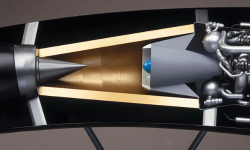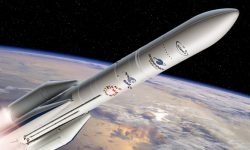
Skylon is an 83-meter long space plane concept
— Actualités du 7 février 2019 —
– News of February 7, 2019 –
Skylon is a space plane developed by Reaction Engines Limited. We can trace the origin of its development in the early 1980s. To solve the difficult equation of a single-stage orbital vehicle (SSTO), the manufacturer is betting on an engine capable of feeding directly into from the atmosphere, called SABRE. The best way to maximize the mass of the propellants relative to the mass of the vehicle is to use propellants that are not contained in the vehicle. SABRE is thus thought to be able to work in two ways.
During the first phases of the flight, it catches its oxidant directly into the atmosphere. The engine burns hydrogen and air. Once at thirty kilometers of altitude, the combustion passes entirely on the internal reservoirs. Pure oxygen is then burned with hydrogen. This operation should allow the Skylon space plane to save a few tons of propellants and thus make the SSTO strategy viable.
The development of the SABRE engine, however, requires a number of technical breakthroughs. The air that enters Mach 5 in the engines must almost instantly be cooled down to -150 degrees Celsius before being injected into the combustion chamber, which requires the design of an extraordinary heat exchanger. A compressor must also ensure that even at low speeds during the first phases of flight, this air is injected into the chamber at 140 bar. And of course these advanced equipment must be as light as a feather.
If a space vehicle such as the Skylon space plane is one day developed, comparative performance compared to a conventional rocket will not really be to its advantage. Despite its huge 83-meter-long fuselage and the hundreds of tonnes of propellant that it would embark, the Skylon space plane could only deliver a few ten tons to the International Space Station. The launch cost per kilo, however, would be excellent because the system would be fully reusable. It is therefore necessary to calculate if such a development is profitable compared to partially reusable rockets that are already able to lower the bill.
Image by Reaction Engines Ltd










